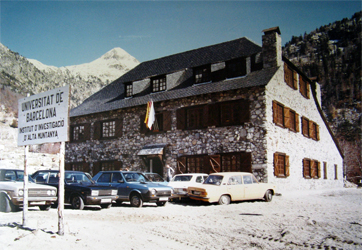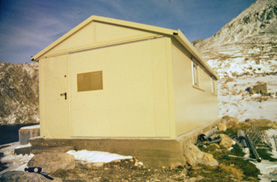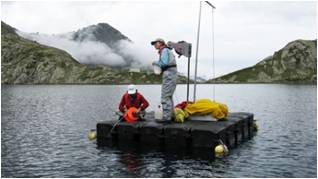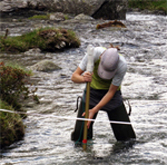History
The direct antecedent of the LOOP has been the Centre for High Mountain Research (CRAM) of the University of Barcelona, which was launched in 1984 by Prof. Ramon Margalef. Since earlier times, Prof. Margalef has stimulated and inspired the limnological work in the Pyrenees. In the 1950’s he released his first studies on plankton from Pyrenean lakes. In 1975, he and his students conducted the first extensive limnological study in the Pyrenees. They sampled more than 30 lakes for chemistry and biology, and involved mountaineering clubs in sampling plankton in a larger number of lakes during their sports excursions, in an early citizen-science experience. The CRAM is located in the Val d’Aran (Central Pyrenees) at 1600 m a.s.l., and it was originally intended as a facility for field-based studies on the limnology of the Pyrenees. It took over leadership in Pyrenean limnology from the laboratory of Orèdon of the University of Toulouse, in the Néouvielle massif, which had been very active during the 1960-70’s. Groups working in the fields of glaciology, geology, botany, and zoology joined the CRAM later on, although the limnological work has remained as the main activity. Since 2002, the CRAM is the base of a team from a Mixed Research Unit, the Limnology Group, composed of researchers of the University of Barcelona (UB) and the Spanish Council of Science (CSIC), who are the core staff of LOOP.
The first activities related to the environmental biogeochemistry of surface waters in the CRAM started in 1984 in Lake Redon (named Redó before the revision of the official toponymy to restore the local names in the late 1990’s). They consisted in a two-year monitoring of the chemistry and the planktonic populations of the lake. This provided the data set used in Jordi Catalan’s Ph. D. Thesis, supervised by Prof. Margalef, which was the first of a series of theses dealing with Pyrenean dynamic limnology that spans until present. In 1986, a survey of the water chemistry of 100 lakes in the Central and Eastern Spanish Pyrenees was carried out, in parallel to the study of the macrophyte populations and the littoral epilithic flora of diatoms as indicators of water quality. Simultaneously (1986-87 period), the chemistry of the atmospheric deposition was studied in four sampling stations at high altitude located along the same area.
In the early 1990’s, researchers at CRAM became members of a consortium of European teams participating in several EU funded projects. In this framework, a research line was started relating limnological dynamics and the climatic and pollution forcing, in order to develop the concept of high mountain lakes as early warning systems of global change. With this aim, a small field station was built on the shore of Lake Redon in 1996, replacing an old storage cabin that had been previously installed. The field station was equipped with an automatic weather station, water level logger and a field lab with the aim to record hydrological, meteorological and limnological parameters of relevance for environmental monitoring. In close relation to this research line, palaeolimnological studies were also started to reconstruct the environmental history of the Pyrenean lakes.
The works mentioned so far were not intended to be a true monitoring. However, they supposed the basis to set the framework of a posterior monitoring of the biogeochemistry of alpine waters as indicators of global change and, though intermittently, they provided the first time series of environmentally relevant data. By the early 2000’s, the idea of maintaining these series and a regular, long term environmental monitoring programme in the Pyrenees took off. At the same time, part of the researchers of the team, which had been until then composed exclusively of members of the Department of Ecology of the University of Barcelona, moved to the Center for Advanced Studies of Blanes (CEAB-CSIC). However the team kept operationally together, and became a sub-unit of the mixed Limnology Group under the denomination of the LOOP. In adition, the LOOP has been formally recognised by CEAB as one of its Observational Facilities.
Since the creation of the LOOP, efforts have been addressed to keep and develop a continuous monitoring programme. Lake Redon still stays as one of the flagship sites for this long term ecological research. But since 2004, works have also started in order to extend the monitoring of surface high mountain waters from the level of a single lake to the whole catchment. Crucial to this has been the participation in the research programme of the Spanish National Parks Network and, in particular, the collaboration with the Aigüestortes i Estany de Sant Maurici (AESM) National Park. The starting point was a project run in 2004-06 aimed to define the monitoring protocols to use one large catchment (the St. Nicolau Valley) in the AESM National Park as a long term ecological research and monitoring site, focusing on surface waters as the factor integrating and reflecting the environmental changes in the catchment. Since 2008, the National Park hosts a long term ecological research node (LTER-Aigüestortes) associated to the LTER-Spain, LTER-Europe and ILTER networks, in which the LOOP participates together with teams from other institutions.
Yet the geographic scope of the LOOP spans beyond the local scale. Synoptic lake surveys conducted not only in the AESM National Park, but also in the whole Pyrenean range, have been the basis for developing a regional Pyrenean limnology. Moreover, the repeated surveys over time provide a view of the environmental changes at the regional scale. The data collection started by Prof. Margalef and coworkers survey in 1975 has been continued in the 1986 survey mentioned above, and subsequent surveys in the framework of several projects in 1994-95, 2000, 2011 and 2024, covering thus a multi-decadal period.
There has not ever been funding specifically assigned to long-term monitoring at the LOOP or its precedent forms. All the activities during its history have been maintained thanks to the concatenation of short-term research projects. In this sense, the collation and re-use of the data produced in such projects to build a general view (in space and time) of the environmental change is an added value to the specific results of each project. A list of the projects that have contributed to the data- and knowledge-base held nowadays at the LOOP can be found here.






